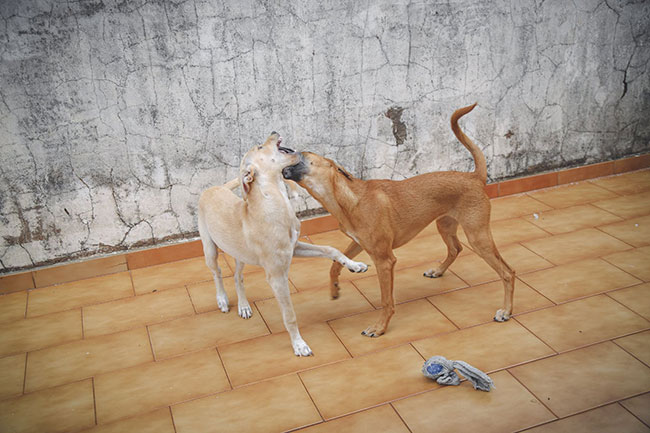
For many of us, dogs are not just pets; they’re family. Their wagging tails and warm nuzzles bring immeasurable joy into our lives. However, even the gentlest canine companion has its limits. Dog bites often top the list of dangerous injuries reported by hospitals, making it essential for us to understand what might trigger a dog to bite and how we can avoid such situations. It’s not just about preventing injuries; it’s about nurturing a harmonious relationship with our four-legged friends.
In this blog post, we delve into the common triggers for dog bites and provide practical advice on how to steer clear of them, ensuring a safer environment for both humans and dogs.
Fear: The Instinctual Snap
When dogs are scared, their fight or flight instinct kicks in, and since they can’t always run away, they might choose to defend themselves. Dog bites top list of dangerous injuries when fear is in the equation because a scared dog is unpredictable.
To avoid this, always approach dogs in a calm and non-threatening manner. Give them the chance to come to you and avoid making direct eye contact, which can be intimidating for them. If a dog appears frightened, it’s best to give them space.
Pain: The Hurtful Reaction
Dogs in pain can be quick to lash out, even if they’re typically sweet-natured. If your dog is injured or ill, be mindful of their discomfort. It’s important to approach your pet gently and, if possible, warn others to do the same. For unfamiliar dogs, always ask the owner before touching them, as you may not know if they are experiencing discomfort.
Territorial Instinct: Guarding Their Haven
Dogs are natural guardians, and they often view their home as their sanctuary. Intrusions, whether from people or other animals, can trigger a protective response. To mitigate this, never enter another person’s property without permission, especially if there’s a dog present.
Teach children to do the same. If you have a dog that’s particularly territorial, consider signs or fences to warn visitors and prevent unwanted encounters.
Resource Guarding: The Protective Chewer
Some dogs view their food, toys, or even human companions as resources to be guarded vehemently. The guarding can lead to aggressive behavior, including biting if they feel their resources are threatened.
Train your dog from an early age to tolerate having people near their food and possessions. If you encounter a dog that’s guarding something, give them space and avoid attempting to take the item away.
Overstimulation: Too Much Of A Good Thing
Even playtime can turn sour if a dog becomes too stimulated. The excitement can escalate, leading to nipping or biting. Monitor your dog’s body language during play. If they become too rough, take a break. Teach your dog to play gently and be consistent with your expectations. Avoid overstimulating environments if your dog doesn’t handle excitement well.
Maternal Instincts: A Mother’s Fury
Female dogs with puppies are incredibly protective and may bite if they perceive a threat to their offspring. Always ask before approaching a mother dog and her litter, and avoid touching the puppies without the owner’s and the dog’s consent. Educate children on the importance of being gentle and respectful around animals, especially new mothers.
Startling A Dog: The Shocked Response
Dogs, much like humans, can react negatively when startled. A sudden touch or loud noise can provoke a defensive bite, especially in older dogs or those with hearing or vision impairments.
To avoid startling dogs, make your presence known in a gentle manner. Avoid sneaking up on them, especially if they’re sleeping or eating. If you’re approaching a dog that might not have seen or heard you, start speaking softly before you get too close. Teach children to do the same and to never surprise a dog.
Lack Of Socialization: The Unfamiliar Fright
Dogs that aren’t adequately socialized may become fearful or aggressive towards unfamiliar people, animals, or environments. This lack of familiarity can lead to biting out of fear or discomfort. As a dog owner, it’s crucial to expose your dog to various people, pets, and settings from a young age, always in a controlled and positive manner.
If you’re interacting with a dog whose socialization status you don’t know, proceed with caution. Let the dog approach you on their terms, and avoid forcing interactions.
Conclusion
Understanding the triggers of dog bites is the first step toward preventing them. By respecting a dog’s space, recognizing signs of discomfort, and approaching them with a calm demeanor, we build a foundation of trust and safety. It’s also vital for dog owners to train and socialize their pets properly, minimizing the chances of aggressive reactions. Whether you’re a dog owner or someone who simply enjoys their company, taking these precautions can help keep both humans and canines out of harm’s way.
Remember, every dog deserves the benefit of the doubt, and with a little knowledge and a lot of compassion, we can prevent dog bites and nurture the loving bond we share with our furry companions.



